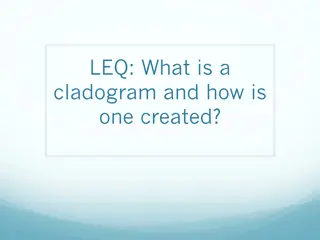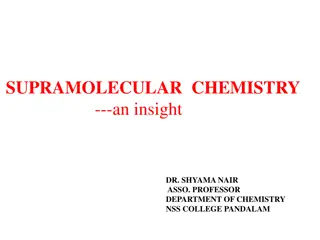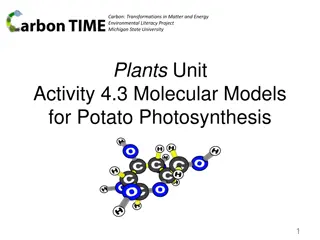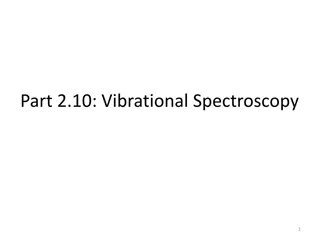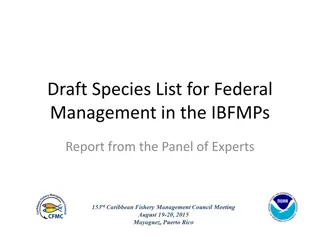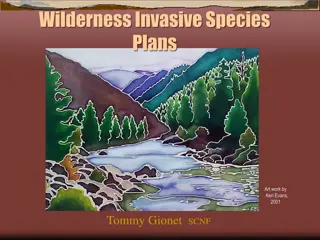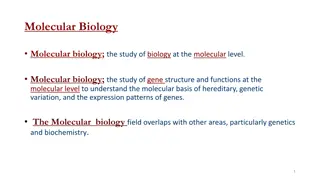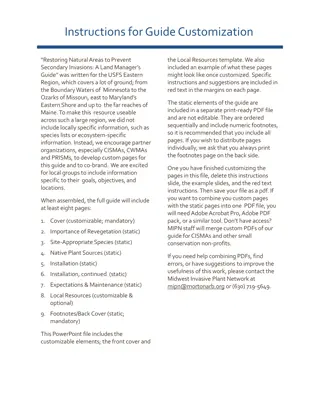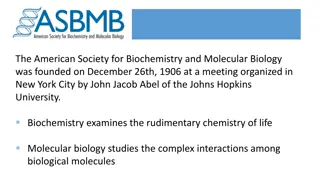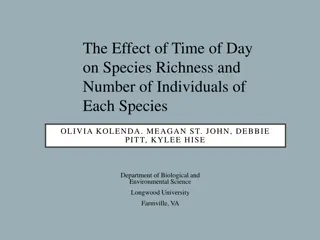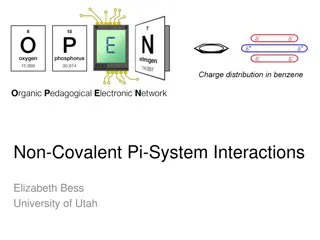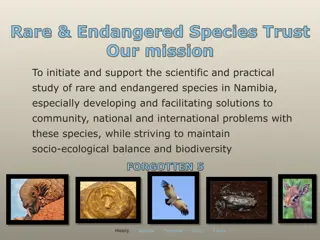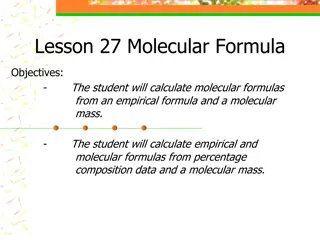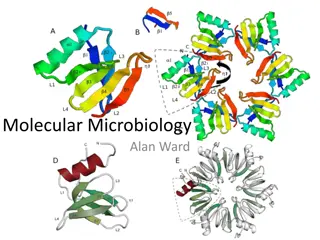Interlocked Species and Mechanomolecules: Exploring Molecular Entanglement
Interlocked species and mechanomolecules represent a fascinating aspect of chemistry involving entanglement of molecular entities like MIMs, mechanical bonds, and mechanomolecules. This intricate bonding leads to unique properties and structural features, as exemplified by catenanes and rotaxanes. Historical contributions from prominent chemists have paved the way for the design and synthesis of complex structures like porphyrin-containing rotaxanes. Understanding the control of molecular geometry and rigidity in these systems is crucial for advancing the field of supramolecular chemistry.
Download Presentation

Please find below an Image/Link to download the presentation.
The content on the website is provided AS IS for your information and personal use only. It may not be sold, licensed, or shared on other websites without obtaining consent from the author.If you encounter any issues during the download, it is possible that the publisher has removed the file from their server.
You are allowed to download the files provided on this website for personal or commercial use, subject to the condition that they are used lawfully. All files are the property of their respective owners.
The content on the website is provided AS IS for your information and personal use only. It may not be sold, licensed, or shared on other websites without obtaining consent from the author.
E N D
Presentation Transcript
- . . 973 : http://pubs.rsc.org/en/content/articlelanding/2014/cs/c4cs0 0029c/unauth#!divAbstract
Interlocked species Interlocked species MIMs Mechanical bond An entanglement in space between two or more molecular entities (component parts) such that they cannot be separated without breaking or distorting chemical bonds between atoms. Component part A group of atoms, or molecular entity , comprised of chemical bonds, which is mutually engaged in mechanical bonding with another molecular entity. Mechanomolecule A molecule possessing one or more mechanical bonds. https://onlinelibrary.wiley.com/doi/pdf/10.1002/9781119044123.ch1
Mechanomolecules Mechanomolecules https://www.researchgate.net/figure/Cartoons-showing-the-main-structural-features- of-a-2catenane-and-a-2-rotaxane-The_fig3_237840290
Some history.. Some history.. 1900-1912, Willstatter : 1930-1950, Ziegler-Hansley-Prelog-Stoll : 1958 Luttringhaus : 1 , 1960 Wasserman : 1 , mgr 1964 Schill : directed
Some history.. Some history.. Freudenberg Cramer 1 Stetter Lihotzky Directed Schill Zollenkopf
Design and synthesis of porphyrin Design and synthesis of porphyrin- -containing and and rotaxanes . . . D / / : through space + - : containing catenanes rotaxanes catenanes
[Cu( CH3CN)4]PF6 Zn (26) (27) - (28) Au(III) 5,10-di-(p-hydroxyphenyl)-15,20-di(3,5-di-tert-butylphenyl)porphyrinate PF6 (29)/ DMF Cs2CO3/DMF (30) 12% (15)+(16)= (30) 5% (30) : (31) 83% NMR (30)-(31) completely different..why? Jonathan A. Faiz , Val rie Heitz and Jean-Pierre Sauvage *
o Thread o 1 or 2 hydroquinol rings o Porphyrins at the ends clipping Sauvage Stoddart
A linear multiporphyrin [2]rotaxane Control of the geometry of Cu(I) Linear arrangement of the porphyrin termini Rigidity due to partial double bond character phenanthroline Linear Maximizing the distance between stoppers and Au-porphyrin
Machines with Mechanical Bonds/Applications Machines with Mechanical Bonds/Applications
Machines with Mechanical Bonds/Applications Machines with Mechanical Bonds/Applications Drug delivery Drug delivery Switching Switching Chiral Catenanes and Rotaxanes : Fundamentals and Emerging Applications Nicholas H. Evans, Chem.Eur.J.,2018,24,3101 3112 https://onlinelibrary.wiley.com/doi/pdf/10.1002/9781119044123.ch1 Asymmetric catalysis Asymmetric catalysis
Summary Summary
Thank you for your attention!!
References References Jonathan A. Faiz , Val rie Heitz and Jean-Pierre Sauvage * (2009). Design and synthesis of porphyrin containing catenanes and rotaxanes Chem. Soc. Rev., 2009, 38 38, 422-442. Chiral Catenanes and Rotaxanes : Fundamentals and Emerging Applications Nicholas H. Evans, Chem.Eur.J.,2018,24,3101 3112 Nicholas H. Evans, Paul D. Beer. Progress in the synthesis and exploitation of catenanes since the Millennium. Chem. Soc. Rev., 2014, 43, 4658- 4683. P. R. Ashton, M. R. Johnston, J. F. Stoddart, M. S. Tolley and J. W. Wheeler, J. Chem. Soc., Chem. Commun., 1992, 1128 http://pubs.rsc.org/en/content/articlelanding/2014/cs/c4cs00029c/unauth#!divAbstract https://books.google.gr/books?hl=en&lr=&id=Gy0XBQAAQBAJ&oi=fnd&pg=PP1&dq=catenanes&ots=WxxEpYZ_Rd&sig=Dcy8zHS- y9V_6dBVLspQxvFZgWA&redir_esc=y#v=onepage&q=catenanes&f=false https://onlinelibrary.wiley.com/doi/pdf/10.1002/9781119044123.ch1 https://www.researchgate.net/figure/Cartoons-showing-the-main-structural-features-of-a-2catenane-and-a-2-rotaxane-The_fig3_237840290 https://onlinelibrary.wiley.com/doi/epdf/10.1002/chem.201704149
Chemistry creates its own object. This creative quality, resembling that of art itself, distinguishes it essentially from natural and historical sciences.



